With the demands of modern PC games, no less than one of the best graphics cards will do, preferably in partnership with one of the best processors. We've reviewed every GPU released in the past several generations from Nvidia, AMD, and Intel, but these 12 are the GPUs that stand out the most.
The best graphics cards at a glance
- Nvidia RTX 4070 Super: The best graphics card for most people.
- Intel Arc B580: A budget GPU that punches far above its weight class.
- Nvidia RTX 4080 Super: The best GPU to pick up if you have a 4K gaming monitor.
- AMD RX 7900 XTX: An excellent alternative to the RTX 4080 Super.
- AMD RX 7900 GRE: The best graphics card AMD has released this generation.
- AMD RX 7700 XT: A great value-focused GPU for 1440p gamers.
- AMD RX 7600: The cheapest GPU from AMD.
- Nvidia RTX 4060: A great GPU for 1080p gaming due to DLSS 3.
- Nvidia RTX 4090: The fastest graphics card money can buy.
- AMD RX 7900 XT: An excellent GPU for VR due to DisplayPort 2.1.
- Nvidia RTX 4070 mobile: More than enough for a gaming laptop.
- Nvidia RTX 4070 Ti Super: A great option if the RTX 4080 is too expensive.
Now is a great time to score a deal on a graphics card as we're winding down the current generation. If you don't mind waiting, however, it might be worth holding out on picking up a GPU. We expect to see new graphics cards launch this year or early next year. Nvidia has its RTX 50-series GPUs, AMD is working on its RDNA 4 offerings, and Intel's Battlemage graphics cards are right around the corner.













The best graphics card for gaming
Nvidia GeForce RTX 4070 Super
- Solid performance improvement over RTX 4070
- Still highly efficient
- DLSS 3.5
- Fantastic ray tracing performance
- Great value
- Only minor uplifts in a few games
- 12GB of VRAM may limit some ray-traced titles at 4K
Why should you buy this: It's much faster than the original model, and it comes in at the same price.
Who's it for: Midrange to high-end gamers looking for a GPU that can handle the most demanding games at 1440p.
What we thought of the Nvidia GeForce RTX 4070 Super:
The RTX 4070 was already a great graphics card, but the RTX 4070 Super is even better. This new version is between 10% and 15% faster than the base model based on our testing, and it still comes with all of the features that made the original version so impressive.
Now, you're getting frame rates at the target resolution that are consistently above 100 fps, and often much more. On top of that the RTX 4070 Super has enough power to press up to 4K, assuming you make a few compromises in the most demanding games. It's the Swiss Army Knife of graphics cards, filling its duty as a gaming workhorse in just about any situation. It even manages to beat AMD's RX 7800 XT, though it's slightly more expensive.
It comes with Nvidia's excellent DLSS 3.5, as well. It's a huge asset in games like Alan Wake 2 with path tracing turned on, and it can make demanding games more playable at 4K. Between DLSS 3, solid raw performance, and an attainable price, the RTX 4070 Super nails a sweet spot that most graphics cards miss.


The best value graphics card
Intel Arc A750
- Lower price than AMD and Nvidia alternatives
- 12GB of VRAM
- XeSS 2 support
- Incredible performance for the price
- Occasional driver issues
- 190W is a lot for a budget GPU
Why should you buy this: It's a powerful graphics card that has no business being as inexpensive as it is.
Who's it for: Gamers who want solid performance under $250
What we thought of the Intel Arc B580:
I'm shocked the Arc B580 is as good as it is. It comes in at $250, but it has no business being that inexpensive. Based on my testing, it's a clean 9% faster than Nvidia's RTX 4060 at 1080p, and a massive 18% faster at 1440p. This is a graphics card that not only goes toe-to-toe with Nvidia and AMD on performance. It also comes in at a much cheaper price.
To me, the Arc B580 feels like a course correction. The market for $250 graphics cards has been woefully underserved for the past few years, but Intel is delivering a GPU with the Arc B580 in that price bracket that's compelling. It's a solid performer, but more than that, it's a capable modern GPU with good ray tracing performance, 12GB of VRAM, and even frame generation support with XeSS 2.
Intel's discrete graphics business is still fairly young, but if I was building a budget PC today, it'd be hard to argue with what the Arc B580 offers. It's capable of just about anything at 1080p, and based on my testing, it even has enough grunt to go up to 1440p. The fact that it's actually cheaper than the competition is just the cherry on top.

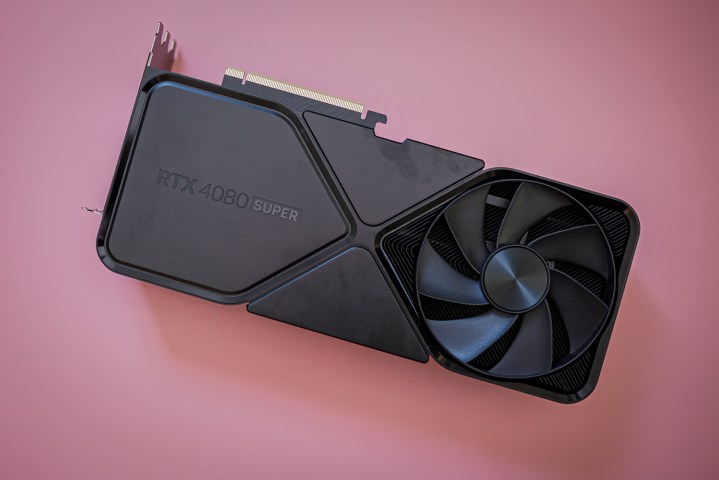
The best graphics card for 4K gaming
Nvidia GeForce RTX 4080 Super
- Great 4K performance
- DLSS 3.5
- Exceptional ray tracing performance
- Very power efficient
- $200 price drop
- Little improvement compared to base RTX 4080
- Power adapter can be unsightly
- Prices may not hold at $1,000
Why should you buy this: The RTX 4080 Super is expensive, but it feels tailor-made for 4K gaming.
Who's it for: 4K gamers who need above 60 fps in the most demanding games.
What we thought of the Nvidia RTX 4080 Super:
The original RTX 4080 was a bit of a disappointment due to its high price, but the RTX 4080 Super corrects that. Coming in at $200 less, it's the premium 4K gaming graphics card that we've been begging for, and it delivers stable performance across a wide swath of games.
Although the RTX 4080 Super isn't quite as powerful as the RTX 4090, features like DLSS 3 help fill in the gap. That makes ray tracing possible at 4K, even at high frame rates. DLSS isn't new, but the addition of frame generation and ray reconstruction on the RTX 4080 Super can massively boost your frame rate in demanding titles.
The card is big and bulky, but unlike the RTX 4090, it doesn't require a ton of power. It stays at the same wattage as the previous generation, and in real-world use, it actually consumes about 50W less.
For video editing, it's tough to beat the RTX 4080. Although there are better value options for gaming, Nvidia still has a massive lead in video editing, and it accelerated tasks in apps like Adobe After Effects and DaVinci Resolve in a way that AMD graphics cards just can't.

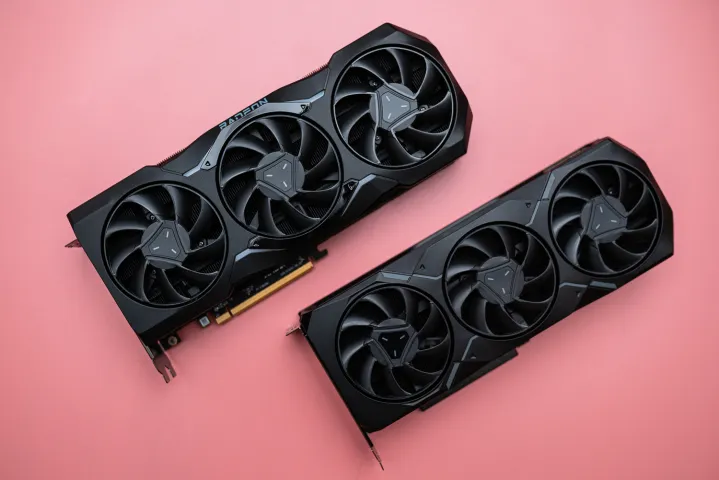
The best AMD graphics card for 4K gaming
AMD Radeon RX 7900 XTX
- Fantastic value for the RX 7900 XTX
- Playable ray tracing performance
- High refresh rate 4K gaming
- Standard 8-pin power
- Disappointing generational improvements
- Loud and hot
Why should you buy this: It offers some of the best 4K gaming performance you can find today, and at a reasonable price.
Who’s it for: High-end gamers who need high frame rates, but don't care much about ray tracing.
What we thought of the AMD Radeon RX 7900 XTX:
The lineup of current-gen GPUs all have one thing in common: they're expensive. That makes choosing the best GPU tough, but AMD has a compelling offer this time around. The RX 7900 XTX offers flagship performance at an excellent value amid the inflated landscape of GPU prices right now.
For raw performance, the RX 7900 XTX is capable of running the most demanding PC above 60 frames per second (fps), and in the case of titles like Red Dead Redemption 2 and Horizon Zero Dawn, it can even hit around 100 fps. The RX 7900 XTX compares favourably with the RTX 4080 Super, though it has lost some rankings since Nvidia dropped the price of its 4K GPU.
In addition, it's smaller, and it calls for standard 8-pin power rather than the 12-pin connector featured on Nvidia's most recent GPUs. That doesn't mean the RX 7900 XTX is without faults. It gets loud and it runs hot and compared to Nvidia, it lacks prowess in ray tracing games.
Even with those caveats, the RX 7900 XTX is an excellent graphics card that can power high-end gaming in demanding titles like Cyberpunk 2077.


The best AMD graphics card
AMD Radeon RX 7900 GRE
- Excellent value
- Often beats RTX 4070 Super
- 16GB of VRAM
- Surprisingly capable at 4K
- FSR 3 momentum is still slow
- Ray tracing performance falls a bit short
Why should you buy this: It's the best AMD graphics card we've seen this generation.
Who's it for: Gamers who want great 1440p and 4K performance and don't care much about ray tracing.
What we thought of the AMD Radeon RX 7900 GRE:
The AMD RX 7900 GRE seems like a mistake. The card was originally released in China several months ago, and it never seemed like it would come to the U.S. Now, it's finally here, and with a bargain bin price of $550.
Comparing the AMD RX 7900 GRE against the RTX 4070, it delivers slightly better performance overall for a lower price. In our review, we call it the best AMD GPU we've seen this generation. It manages to match the RTX 4070 Super at a lower price, while outclassing the RTX 4070 by around 15% at the same price.
For frame chasers, the RX 7900 GRE is the best GPU at this price, and we recommend it as a strong RTX 4070 alternative. The main reason the RX 7900 GRE loses out from a top slot is the RTX 4070 Super - for a slight premium, you have access to better ray tracing performance and DLSS.

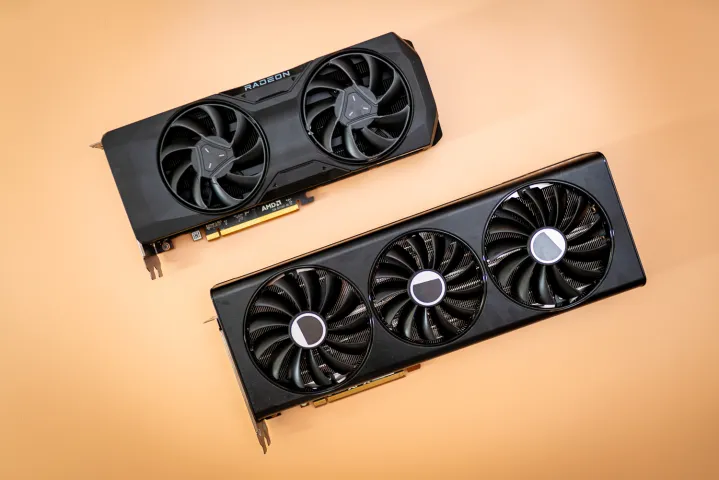
The best graphics card for 1440p
AMD RX 7700 XT
- Reasonably priced
- 100-plus fps at 1440p
- Solid ray tracing performance
- Plenty of VRAM
- Standard 8-pin power
- No DLSS
- Still weaker than Nvidia with ray tracing
Why should you buy this: It's a great deal with recent price drops.
Who's it for: Gamers who want 1440p gaming in the triple digits without breaking the bank.
What we thought of the AMD RX 7700 XT:
As we've seen with a lot of AMD GPUs this generation, the RX 7700 XT is a much better buy now than it was at launch. You can find it for around $380, which is a great price considering the performance. Our comparison of the AMD RX 7700 XT and Nvidia RTX 4060 Ti found the RX 7700 XT to be around 23% faster than Nvidia's GPU, and that includes games with ray tracing.
Although Nvidia has some excellent GPUs at other price points this generation, there aren't a ton of options around $400. The RX 7700 XT fills that gap perfectly. It offers much better performance than the Nvidia competition at this price, and it even nears the performance level of the $550 RTX 4070 in some titles.
The RX 7700 XT is best if you're on a strict budget, however. A slightly more expensive card like the RX 7800 XT or RTX 4070 Super gains you a lot of extra performance at 1440p. For those trying to stay under $400, though, nothing beats the RX 7700 XT.

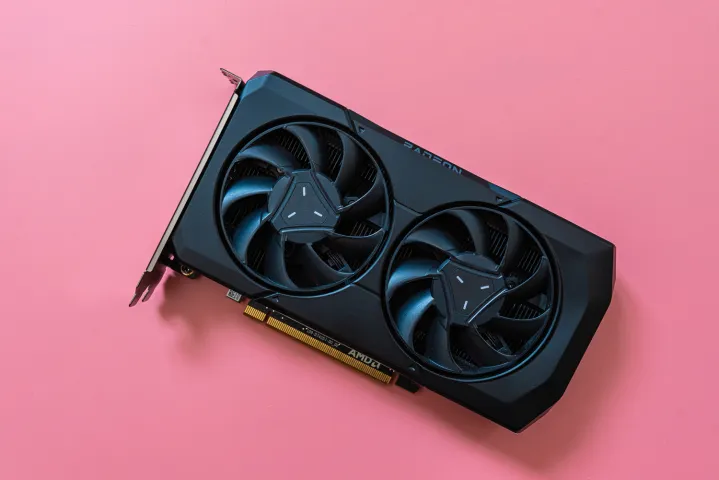
The best graphics card under $300
AMD Radeon RX 7600
- Solid 1080p gaming performance
- Aggressive pricing
- Only a single 8-pin power connector
- Compact design
- Memory interface limits higher resolutions
- Ray tracing performance is lacking
Why should you buy this: It's a solid 1080p graphics card at a reasonable price.
Who’s it for: 1080p gamers on a tight budget.
What we thought of the AMD Radeon RX 7600:
The RX 7600 isn't a showstopper graphics card, but it's the closest we've seen to a true budget offering this generation. Arriving art $270, the GPU offers above 60 fps in demanding titles like Cyberpunk 2077 at 1080p.
That's what you want out of a graphics card under $300. Versus the Nvidia RTX 4060, the AMD Radeon RX 7600 manages to meet, and often exceed, the 60 fps mark for demanding titles at 1080p. It also supports AMD's FidelityFX Super Resolution (FSR), so it can scale up to higher frame rates in titles like Starfield and Alan Wake 2.
The card only really loses out when it comes to ray tracing. AMD cards aren't great when it comes to ray tracing, and this budget-focused offering doesn't change that story. It can handle some lighter ray tracing in games like Resident Evil 4, but you'll need to turn off the feature in anything more demanding.


The best graphics card for 1080p
Nvidia RTX 4060
- DLSS 3
- Excellent efficiency
- Price reduction compared to last-gen
- Strong ray tracing performance
- Beaten by cards that are only $30 more
- Limited memory interface
- Weak at higher resolutions
Why should you buy this: It's the cheapest way to unlock Nvidia's impressive DLSS 3 tech.
Who’s it for: Budget gamers who still want access to the latest tech.
What we thought of the Nvidia RTX 4060:
Although the RX 7600 remains our recommendation for 1080p gamers on a budget, the RTX 4060 is still a potent option. It offers similar performance at a $30 premium, but spending a little extra unlocks faster ray tracing performance and Nvidia's coveted DLSS 3.5.
The frame generation can make a massive difference. At this price, you wouldn't expect to run Cyberpunk 2077 above 60 fps at 1440p, but DLSS 3 allows the RTX 4060 to hit almost 100 fps with ease. It doesn't apply in every game, but you'll appreciate the frame generation when it pops up.
Nvidia's tech is the main draw to the RTX 4060. But if you're looking for raw value, the RX 7600 offers similar and sometimes better performance for around the same price, and Intel's Arc A750 is off the charts when it comes to value. The RTX 4060 alternatives fall short if you ignore Nvidia's advantage in ray tracing and frame generation.

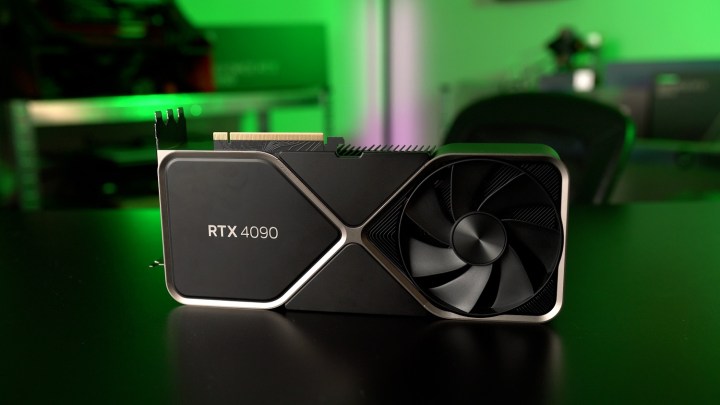
The best graphics card for AI
Nvidia GeForce RTX 4090
- Huge leaps in 4K gaming performance
- Excellent ray tracing performance
- High power and thermals, but manageable
- DLSS 3 performance is off the charts
- Very expensive
- DLSS 3 image quality needs some work
Why should you buy this: It's the most powerful graphics card you can buy today, hands down.
Who’s it for: High-end enthusiasts that want the best of the best regardless of price.
What we thought of the Nvidia GeForce RTX 4090:
The RTX 4090 is a nonsense graphics card, and we mean that in the best way possible. It's $1,600, which is hard to justify spending on any graphics card. But if you want the best of the best, the RTX 4090 is it, and by a significant margin.
The previous GPU champion, the RTX 3090 Ti, looks puny by comparison. Based on our testing, the RTX 4090 is nearly 70% faster than the RTX 3090 Ti, and almost 90% faster than the RTX 3090. It's a 4K graphics card that enables features like ray tracing in the most demanding games available today.
It's overkill for most people, and it comes with some high demands. You'll need a decent power supply for the RTX 4090 (and the RTX 4080) with a lot of wattage, and you'll need a case to accommodate the card's massive size. It's a reasonable trade-off for high-end enthusiasts, though, especially with features like DLSS 3 on offer.
On top of that, it's an absolute monster when it comes to AI. The massive GPU helps, but the real draw is 24GB of VRAM for running Large Language Models (LLM) and other AI applications.


The best graphics card for VR
AMD Radeon RX 7900 XT
- DisplayPort 2.1 support
- Powerful 4K gaming
- Relatively small
- Disappointing generational improvements
- Loud and hot
Why should you buy this: It's a powerful 4K GPU, and it supports DisplayPort 2.1 for high-end VR headsets.
Who's it for: VR enthusiasts who want to drive high-end headsets.
What we thought of the AMD Radeon RX 7900 XT:
The AMD RX 7900 XT wasn't a great GPU when it released, but it's become much better since. It's seen a wave of price drops, bringing the $900 list price down to around $700. It's a great buy at that price, espeically if you're in the market for high-end VR gaming.
The big reason the RX 7900 XT stands out so much is its DisplayPort 2.1 support. High-end VR headsets often come with insane resolutions and refresh rates, which require DisplayPort 2.1. The RX 7900 XT is able to work with these headsets due to its connection.
It's no slouch of a GPU, either. Although the RX 7900 XTX is more powerful for 4K, the RX 7900 XT has enough grunt to play most demanding games at 4K and 60 fps. You may have to turn down settings in a few titles, but those situations should be few and far between.

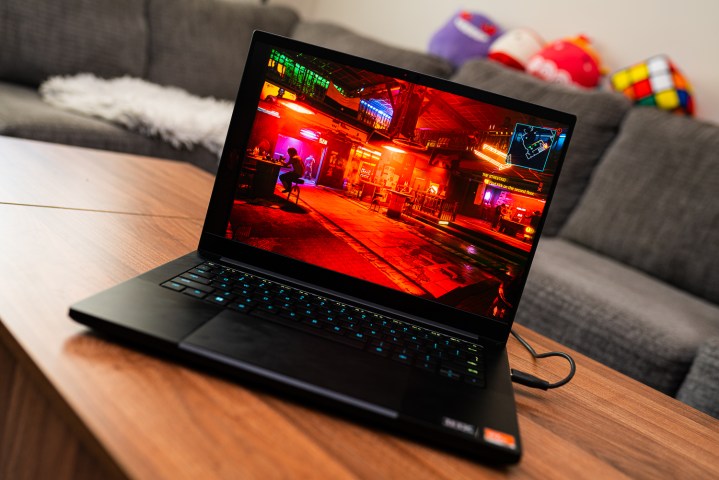
The best graphics card for laptops
Nvidia GeForce RTX 4070 mobile
- Available in a ton of laptops
- DLSS 3.5 support
- Efficient enough for thin and light machines
- A little expensive
- Struggles at 4K
Why should you buy this: It's the sweet spot of Nvidia's current mobile lineup of GPUs.
Who's it for: Gamers on the go that need the perfect balance of power.
What we thought of the Nvidia GeForce RTX 4070 mobile:
If you want the ultimate mobile gaming experience, it's hard to beat the RTX 4070 mobile. It's not the fastest laptop graphics card Nvidia currently offers, but it's by far the best. It's available in a massive number of laptops, including the Lenovo Legion Pro 5 and Razer Blade 14, and all of them offer great performance at a 1440p resolution.
What's most impressive about the RTX 4070 mobile, however, is that it's scalable. You can pump it with power in a large, 16-inch laptop for a small performance boost, but the efficiency of the GPU means it has a home in thinner machines like the Asus ROG Zephyrus G14.
It also has access to DLSS 3.5, making things like ray tracing possible on a laptop. You won't find the RTX 4070 available in more budget-focused machines, but if you have the cash to spare, it definitely strikes the perfect balance of efficiency and power for a laptop.

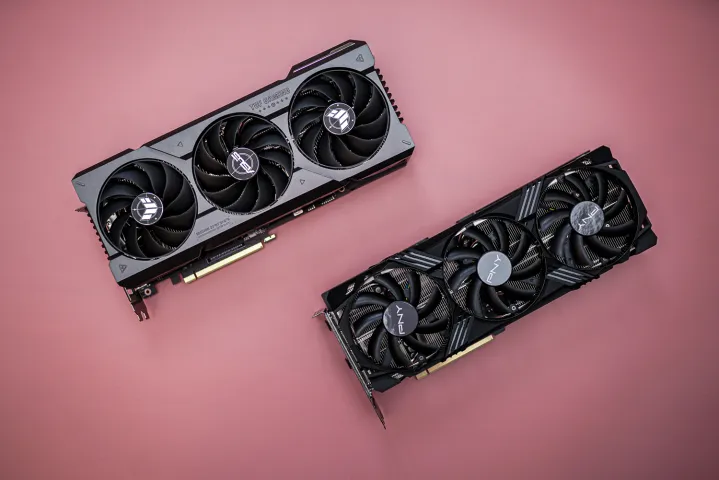
The best graphics card with DLSS 3
Nvidia GeForce RTX 4070 Ti Super
- DLSS 3.5
- Solid improvement over RTX 4070 Ti
- Excellent ray tracing performance
- Fantastic power effciency
- Still too expensive
- Occasionally struggles at 4K
Why should you buy this: It's only OK on its own, but the RTX 4070 Ti Super shines with DLSS 3.
Who's it for: Gamers who want flagship performance but don't have an unlimited budget.
What we thought of the Nvidia GeForce RTX 4070 Ti Super:
The RTX 4070 Ti wasn't a perfect graphics card. The RTX 4070 Ti Super corrects some of the mistakes of the base model, however. It comes in at the same $800 price, but with a solid 10% boost in performance over the base model. Still, what really stands out for this GPU is DLSS 3.
DLSS 3 adds DLSS Frame Generation, allowing you to massively improve your frame rate in games like Atomic Heart, Cyberpunk 2077, and, Warhammer 40:000: Darktide. It's exclusive to Nvidia's most recent generation, and although DLSS 3 isn't available in every game, it's a selling point in the few demanding titles that feature the tech.
In standard performance, the RTX 4070 Ti Super delivers 4K gaming performance on the level of last-gen flagships, narrowly beating out cards like the RTX 3090. It's still a very powerful GPU, even if it's a bit expensive for the current generation. The good news is that this Super refresh has pushed prices down to the $800 list price.

Frequently Asked Questions
As a rule of thumb, you should dedicate about 30% of your budget to a graphics card for a gaming PC. For 1080p, you should spend around $300 to $400; for 1440p, around $400 to $500; and for 4K, $600 or above. The GeForce RTX 4060 targets 1080p at $300, the Radeon RX 7800 XT is great for 1440p at $500, and the GeForce RTX 4070 Ti Super is the perfect video card for 4K at $800.
Unlike a few years ago, you can commonly find graphics cards on sale. If you're interested in a particular model, make sure to shop around to find a good deal.
Nvidia and AMD recommend power supply wattage for their most recent graphics card. The Radeon RX 7800 XT, for example, draws 263W of power and AMD recommends a 600W PSU at least. Similarly, the GeForce RTX 4080 video card draws 320W and Nvidia recommends a 750W PSU. These recommendations aren't always perfect, though, so we recommend using a PSU calculator.
Finding the graphics card that will best suit your needs comes down to the resolution of your display and the kinds of games you play. The Nvidia GeForce RTX 4080 Super is great for 4K, for example, but it's overkill for 1080p where the AMD Radeon RX 7600 shines. The lower your display's resolution, the less you need to spend on a graphics card.
Beyond that, consider the games you want to play and at what frame rates. You can use the Nvidia GeForce GTX 1660 Super for everything from Counter-Strike 2 to Borderlands 3, but you might need to step up to the GeForce RTX 4060 to play games like Cyberpunk 2077.
If you're new to graphics cards and PC gaming in general, make sure to check out our guide on how to install a graphics card and our guide on the best GPU deals currently available.





